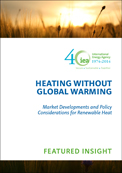Heating without global warming
 Global energy use for heat accounts for more than 50% of final energy consumption and has important implications on energy security and energy-related CO2 emissions. Nonetheless, efforts to replace fossil-generated heat with renewable energy sources, are only slowly gaining momentum as renewable heat does not receive the attention it deserves in light of its vast potential at costs that are competitive with those of fossil fuel-derived heat in an increasing number of circumstances. This paper highlights some of the dynamics of renewable energy use for heat in different markets, the status of different technologies and policy measures to efficiently promote renewable heat, and provides an outlook for the potential role of renewable heat in the medium- and long-term.
Global energy use for heat accounts for more than 50% of final energy consumption and has important implications on energy security and energy-related CO2 emissions. Nonetheless, efforts to replace fossil-generated heat with renewable energy sources, are only slowly gaining momentum as renewable heat does not receive the attention it deserves in light of its vast potential at costs that are competitive with those of fossil fuel-derived heat in an increasing number of circumstances. This paper highlights some of the dynamics of renewable energy use for heat in different markets, the status of different technologies and policy measures to efficiently promote renewable heat, and provides an outlook for the potential role of renewable heat in the medium- and long-term.
Related Content
- Beating the heat: investing in pro-poor solutions for urban resilience
- No time to lose, says Sunita Narain on the new IPCC report
- Too hot to work: assessing the threats climate change poses to outdoor workers
- Working on a warmer planet: the effect of heat stress on productivity and decent work
- The Future We Don’t Want: how climate change could impact the world’s greatest cities
- 2017 was world’s hottest year ever without El Nino, says Nasa
